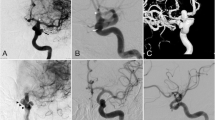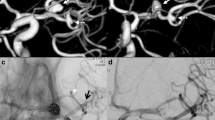Abstract
Objectives
We performed this study to report our experience using a stepwise stent deployment technique for the treatment of tandem intracranial aneurysms.
Methods
Patients with intracranial tandem aneurysms that were treated with a stepwise stent deployment technique between May 2009 and June 2013 were retrospectively reviewed.
Results
Twenty-one patients with 42 tandem aneurysms were identified (11 men, 10 women), with a mean age of 53.7 years (range, 17–82 years). Subarachnoid haemorrhage was confirmed in 12 patients using computed tomography at onset. Complete occlusion was achieved in 20 of the aneurysms (47.6 %) after the procedure, neck remnant in 9 (21.4 %), and aneurysm remnant in 13 (31.0 %). The perioperative complications included in-stent thrombosis in one case and vasospasm in two cases, none of which left a permanent neurological deficit. The modified Rankin Scale (mRS) score at discharge was 0–2 in 20 cases and 3 in one case. The follow-up angiograms available for 17 patients showed complete occlusion in 26 aneurysms, improved in 4, and stable in 4. All of the patients had mRS scores of 0–1 during the clinical follow-up period.
Conclusions
The stepwise stent deployment technique is feasible and helpful in the treatment of intracranial tandem aneurysms.
Key Points
• Treating wide-necked intracranial aneurysms with stent-assisted coiling is preferable.
• Tandem wide-necked intracranial aneurysms can be treated with a single stent.
• Stepwise stent deployment is technically feasible for embolizing tandem intracranial aneurysms.




Similar content being viewed by others
Abbreviations
- mRS:
-
Modified Rankin Scale
- ACA:
-
Anterior cerebral artery
- AChA:
-
Anterior choroidal artery
- MCA:
-
Middle cerebral artery
- PCoA:
-
Posterior communicating artery
- ICA:
-
Internal carotid artery
- SAH:
-
Subarachnoid haemorrhage
- SAC:
-
Stent-assisted coiling
References
Ostergaard JR, Hog E (1985) Incidence of multiple intracranial aneurysms. Influence of arterial hypertension and gender. J Neurosurg 63:49–55
Rinne J, Hernesniemi J, Puranen M, Saari T (1994) Multiple intracranial aneurysms in a defined population: prospective angiographic and clinical study. Neurosurgery 35:803–808
Vajda J (1992) Multiple intracranial aneurysms: a high risk condition. Acta Neurochir (Wien) 118:59–75
Lin N, Brouillard AM, Xiang J et al (2015) Endovascular management of adjacent tandem intracranial aneurysms: utilization of stent-assisted coiling and flow diversion. Acta Neurochir (Wien) 157:379–387
Raz E, Shapiro M, Becske T et al (2015) Anterior choroidal artery patency and clinical follow-Up after coverage with the pipeline embolization device. AJNR Am J Neuroradiol. doi:10.3174/ajnr.A4217
Shapiro M, Becske T, Riina HA et al (2014) Toward an endovascular internal carotid artery classification system. AJNR Am J Neuroradiol 35:230–236
Raymond J, Guilbert F, Weill A et al (2003) Long-term angiographic recurrences after selective endovascular treatment of aneurysms with detachable coils. Stroke 34:1398–1403
Yang PF, Liu JM, Huang QH et al (2010) Preliminary experience and short-term follow-up results of treatment of wide-necked or fusiform cerebral aneurysms with a self-expanding, closed-cell, retractable stent. J Clin Neurosci 17:837–841
Pumar JM, Blanco M, Vazquez F, Castineira JA, Guimaraens L, Garcia-Allut A (2005) Preliminary experience with Leo self-expanding stent for the treatment of intracranial aneurysms. AJNR Am J Neuroradiol 26:2573–2577
Zhao KJ, Zhang YW, Xu Y et al (2013) Reconstruction of saccular and dissected intracranial aneurysms using Solitaire AB stents. PLoS One 8, e57253
Ebrahimi N, Claus B, Lee CY, Biondi A, Benndorf G (2007) Stent conformity in curved vascular models with simulated aneurysm necks using flat-panel CT: an in vitro study. AJNR Am J Neuroradiol 28:823–829
Hong B, Patel NV, Gounis MJ et al (2009) Semi-jailing technique for coil embolization of complex, wide-necked intracranial aneurysms. Neurosurgery 65:1131–1138, discussion 1138–1139
Biondi A, Janardhan V, Katz JM, Salvaggio K, Riina HA, Gobin YP (2007) Neuroform stent-assisted coil embolization of wide-neck intracranial aneurysms: strategies in stent deployment and midterm follow-up. Neurosurgery 61:460–468, discussion 468–469
Kulcsar Z, Goricke SL, Gizewski ER et al (2013) Neuroform stent-assisted treatment of intracranial aneurysms: long-term follow-up study of aneurysm recurrence and in-stent stenosis rates. Neuroradiology 55:459–465
Shapiro M, Becske T, Sahlein D, Babb J, Nelson PK (2012) Stent-supported aneurysm coiling: a literature survey of treatment and follow-up. AJNR Am J Neuroradiol 33:159–163
Chalouhi N, Jabbour P, Singhal S et al (2013) Stent-assisted coiling of intracranial aneurysms: predictors of complications, recanalization, and outcome in 508 cases. Stroke 44:1348–1353
Yang P, Zhao K, Zhou Y et al (2015) Stent-assisted coil placement for the treatment of 211 acutely ruptured wide-necked intracranial aneurysms: a single-center 11-year experience. Radiology. doi:10.1148/radiol. 2015140974:140974
Chalouhi N, Jabbour P, Kung D, Hasan D (2012) Safety and efficacy of Tirofiban in stent-assisted coil embolization of intracranial aneurysms. Neurosurgery. doi:10.1227/NEU.0b013e31826213f9
Lodi Y, Latorre J, El-Zammar Z et al (2011) Single stage versus multi-staged stent-assisted endovascular repair of intracranial aneurysms. J Vasc Interv Neurol 4:24–28
Greving JP, Wermer MJ, Brown RD Jr et al (2014) Development of the PHASES score for prediction of risk of rupture of intracranial aneurysms: a pooled analysis of six prospective cohort studies. Lancet Neurol 13:59–66
(2013) China's expert consensus on endovascular treatment of intracranial aneurysms. Natl Med J China 93:3093–3103
Ahn JY, Chung SS, Lee BH et al (2005) Treatment of spontaneous arterial dissections with stent placement for preservation of the parent artery. Acta Neurochir (Wien) 147:265–273, discussion 273
Cohen JE, Gomori JM, Umansky F (2003) Endovascular management of spontaneous bilateral symptomatic vertebral artery dissections. AJNR Am J Neuroradiol 24:2052–2056
Kitanaka C, Tanaka J, Kuwahara M et al (1994) Nonsurgical treatment of unruptured intracranial vertebral artery dissection with serial follow-up angiography. J Neurosurg 80:667–674
Acknowledgements
The scientific guarantor of this publication is Jian-Min Liu. The authors of this manuscript declare no relationships with any companies whose products or services may be related to the subject matter of the article. This study has received funding by the Foundation of Shanghai Public Health Bureau (No. 20114232), Shanghai Science and Technology Development Funds (No 13140903201), the Major Programs of the Changhai Hospital during the 12th Five-Year Plan Period (No. CH125520103), and the National Natural Science Foundation of China (No. 81301004, 81271271). Yi-Bin Fang kindly provided statistical advice for this manuscript. No complex statistical methods were necessary for this paper. Institutional review board approval was obtained. Written informed consent was obtained from all subjects (patients) in this study. No study subjects or cohorts have been previously reported. Methodology: retrospective, observational, performed at one institution. Yi-Bin Fang and Zhao-Long Zhang contributed equally to this work.
Author information
Authors and Affiliations
Corresponding authors
Additional information
Yi-Bin Fang and Zhao-Long Zhang contributed equally to this work and are both first co-authors.
Rights and permissions
About this article
Cite this article
Fang, YB., Zhang, ZL., Yang, PF. et al. Stepwise stent deployment technique for tandem intracranial aneurysms: a review of 21 cases. Eur Radiol 26, 351–358 (2016). https://doi.org/10.1007/s00330-015-3823-z
Received:
Revised:
Accepted:
Published:
Issue Date:
DOI: https://doi.org/10.1007/s00330-015-3823-z




